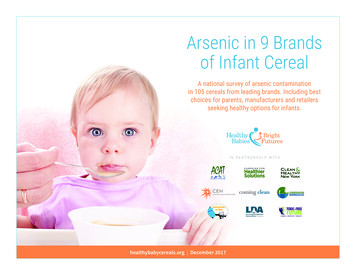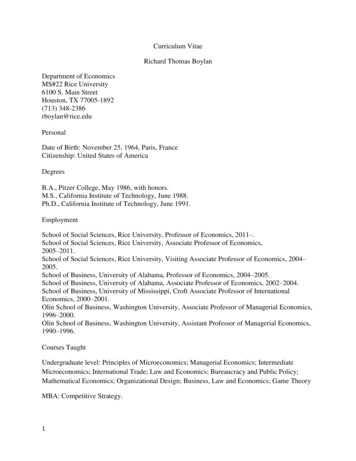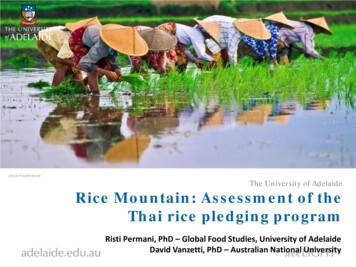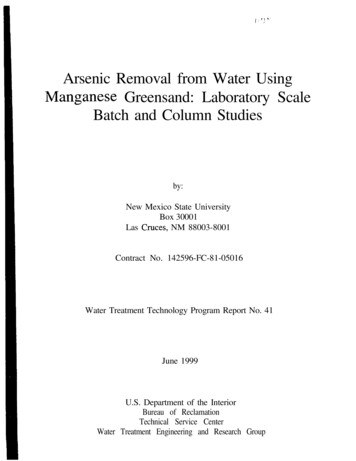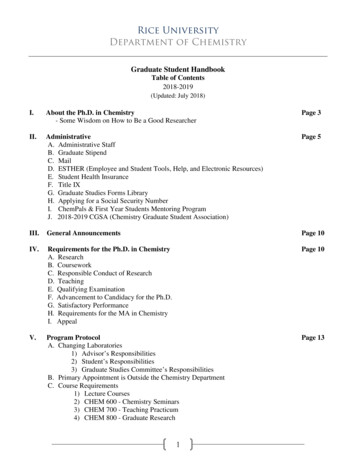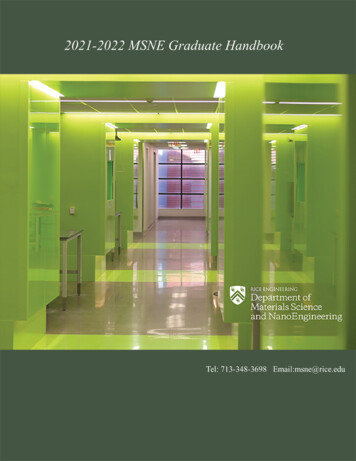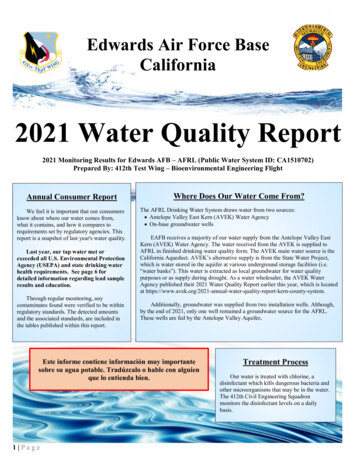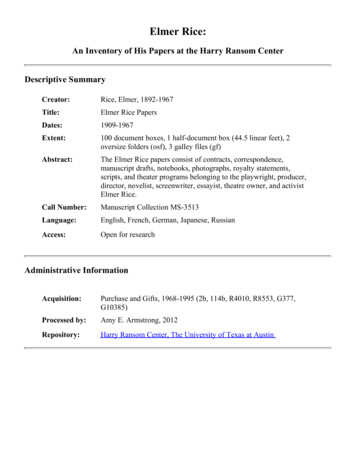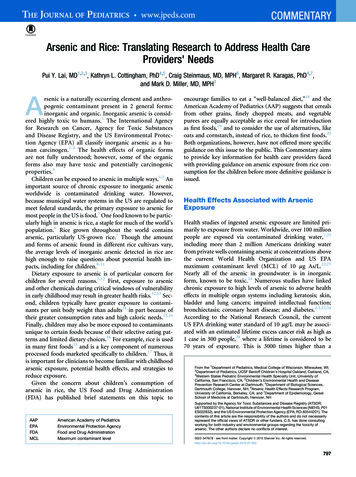
Transcription
Arsenic and Rice: Translating Research to Address Health CareProviders' NeedsPui Y. Lai, MD1,2,3, Kathryn L. Cottingham, PhD4,5, Craig Steinmaus, MD, MPH6, Margaret R. Karagas, PhD4,7,and Mark D. Miller, MD, MPH3Arsenic is a naturally occurring element and anthropogenic contaminant present in 2 general forms:inorganic and organic. Inorganic arsenic is considered highly toxic to humans.1 The International Agencyfor Research on Cancer, Agency for Toxic Substancesand Disease Registry, and the US Environmental Protection Agency (EPA) all classify inorganic arsenic as a human carcinogen.2-4 The health effects of organic formsare not fully understood; however, some of the organicforms also may have toxic and potentially carcinogenicproperties.5Children can be exposed to arsenic in multiple ways.1,3 Animportant source of chronic exposure to inorganic arsenicworldwide is contaminated drinking water. However,because municipal water systems in the US are regulated tomeet federal standards, the primary exposure to arsenic formost people in the US is food.3 One food known to be particularly high in arsenic is rice, a staple for much of the world’spopulation.6 Rice grown throughout the world containsarsenic, particularly US-grown rice.7 Though the amountand forms of arsenic found in different rice cultivars vary,the average levels of inorganic arsenic detected in rice arehigh enough to raise questions about potential health impacts, including for children.8-11Dietary exposure to arsenic is of particular concern forchildren for several reasons.5,12 First, exposure to arsenicand other chemicals during critical windows of vulnerabilityin early childhood may result in greater health risks.12,13 Second, children typically have greater exposure to contaminants per unit body weight than adults14 in part because oftheir greater consumption rates and high caloric needs.15,16Finally, children may also be more exposed to contaminantsunique to certain foods because of their selective eating patterns and limited dietary choices.16 For example, rice is usedin many first foods15 and is a key component of numerousprocessed foods marketed specifically to children.17 Thus, itis important for clinicians to become familiar with childhoodarsenic exposure, potential health effects, and strategies toreduce exposure.Given the concern about children’s consumption ofarsenic in rice, the US Food and Drug Administration(FDA) has published brief statements on this topic toAAPEPAFDAMCLAmerican Academy of PediatricsEnvironmental Protection AgencyFood and Drug AdministrationMaximum contaminant levelencourage families to eat a “well-balanced diet,”18 and theAmerican Academy of Pediatrics (AAP) suggests that cerealsfrom other grains, finely chopped meats, and vegetablepurees are equally acceptable as rice cereal for introductionas first foods,19 and to consider the use of alternatives, likeoats and cornstarch, instead of rice, to thicken first foods.20Both organizations, however, have not offered more specificguidance on this issue to the public. This Commentary aimsto provide key information for health care providers facedwith providing guidance on arsenic exposure from rice consumption for the children before more definitive guidance isissued.Health Effects Associated with ArsenicExposureHealth studies of ingested arsenic exposure are limited primarily to exposure from water. Worldwide, over 100 millionpeople are exposed via contaminated drinking water,7,21including more than 2 million Americans drinking waterfrom private wells containing arsenic at concentrations abovethe current World Health Organization and US EPAmaximum contaminant level (MCL) of 10 mg As/L.22,23Nearly all of the arsenic in groundwater is in inorganicform, known to be toxic.24 Numerous studies have linkedchronic exposure to high levels of arsenic to adverse healtheffects in multiple organ systems including keratosis; skin,bladder and lung cancers; impaired intellectual function;bronchiectasis; coronary heart disease; and diabetes.2,3,22,24According to the National Research Council, the currentUS EPA drinking water standard of 10 mg/L may be associated with an estimated lifetime excess cancer risk as high as1 case in 300 people,24 where a lifetime is considered to be70 years of exposure. This is 3000 times higher than aFrom the 1Department of Pediatrics, Medical College of Wisconsin, Milwaukee, WI;2Department of Pediatrics, UCSF Benioff Children’s Hospital Oakland, Oakland, CA;3Western States Pediatric Environmental Health Specialty Unit, University ofCalifornia, San Francisco, CA; 4Children’s Environmental Health and DiseasePrevention Research Center at Dartmouth; 5Department of Biological Sciences,Dartmouth College, Hanover, NH; 6Arsenic Health Effects Research Program,University of California, Berkeley, CA; and 7Department of Epidemiology, GeiselSchool of Medicine at Dartmouth, Hanover, NHSupported by the Agency for Toxic Substances and Disease Registry (ATSDR;U61TS000237-01), National Institute of Environmental Health Sciences (NIEHS; P01ES022832), and the US Environmental Protection Agency (EPA; RD-83544201). Thecontents of this article are the responsibility of the authors and do not necessarilyrepresent the official views of ATSDR or other funders. C.S. has done consultingworking for both industry and environmental groups regarding the toxicity ofarsenic. The other authors declare no conflicts of interest.0022-3476// - see front matter. Copyright ª 2015 Elsevier Inc. All rights .003797
THE JOURNAL OF PEDIATRICS www.jpeds.comcommonly accepted cancer risk for an environmental carcinogen of 1 case in 1 000 000 people.Effects of prenatal and early childhood exposure to highlevels of arsenic can be substantial.25,26 Arsenic readily passesthrough the placenta,1,27 and epidemiologic studies inBangladesh, Chile, and Taiwan have linked in utero exposureto low birth weight,28 spontaneous abortions, infant mortality,29-32 and increased risk of lung cancer later in life.33 Moreover, emerging evidence links maternal exposure to low dosesof arsenic in drinking water ( 5-10 mg/L) during pregnancyto increased infections during infancy.34 In contrast, thereappears to be limited transfer of arsenic into breast milk inboth highly exposed populations27,35,36 and less exposedpopulations,37,38 suggesting that breastfeeding may reduceexposure. Exposure may occur in formula-fed babies throughboth the formula powder and drinking water.15,37Developing fetuses and children have both enhancedvulnerability and a longer post-exposure lifespan than adults.Effects with long latency periods, such as carcinogenic action,have a greater opportunity to manifest after early life exposure.16,34 Enhanced vulnerability was identified in researchof heavily exposed populations in northern Chile that indicates in utero or early life exposures to ingested arsenic areassociated with high mortality rates of bronchiectasis, acutemyocardial infarction, and bladder, laryngeal, and lung cancers.39 Recent data also suggest that in utero or early lifeexposure is associated with decreased lung function asadults40 and excess relative risks of lung cancer and bladdercancer, which are 2 to 4 times higher than those who wereexposed later in life.33 Early life exposure has also been associated with neurocognitive and motor impairment,41-44 aswell as decreased IQ.45High Arsenic Concentrations in RiceLiterature regarding the presence of arsenic in rice promptedthe US FDA to extensively test different brands of rice grainsand rice products sold in the US for inorganic arsenic.46Based on data published in 2013, all of the 1343 samples contained inorganic arsenic. Though there is a variable amountof arsenic in the products sampled, nearly one-third (30%)contained high levels of inorganic arsenic ( 4 mg perserving), which at a consumption rate of 2.5 servings a daycould pose an estimated lifetime excess cancer risk at orabove 1 case in 300 people, by comparison with the currentwater MCL. One of the hot rice bran cereals sampled, thoughan outlier, contained as much as 30 mg of inorganic arsenicper serving.46 Moreover, many of the products containinghigh levels of arsenic may be consumed by children,including rice cakes and bakery mixes/pudding.46Rice generally contains more arsenic than other grainsbecause of its anaerobic growing environment and uniquephysiology. In flooded rice paddies, arsenic is brought intothe plant by its silicon transporters, and then used in placeof silicon to strengthen the plant stem and husks, includingthe part of the plant we eat.7 There is wide variation in totaland inorganic arsenic concentrations across different types of798Vol. 167, No. 4rice and growing locations. Limited sampling indicates thatin general, rice grown in the South Central US (Arkansas,Missouri, Louisiana, and Texas) contains more arsenic thanrice grown in California.7,47 This may in part be a result ofthe historical application of arsenic-containing pesticidesfrom the legacy of cotton production in the region, whichhas since been converted to rice production.7,47 In comparingacross types and locations, inorganic arsenic concentrationsappear to be lowest in sushi rice from the US and Basmatirice from California, India, or Pakistan.48 Within any onetype of rice, brown rice contains more arsenic than whiterice because arsenic accumulates in the bran, which is thehard outer layer of the grain seen in brown rice.7,8 Removalof this layer produces white rice, thereby eliminating aportion of the arsenic. However, the bran also contains nutritious fiber and vitamins,7 so even though brown rice onaverage contains more inorganic arsenic, it also providesmore nutrition.Rice is a Major Contributor to Dietary ArsenicExposureStudies conducted in the US have shown a positive relationship between rice consumption and urinary arsenic excretion, which is directly related to overall arsenic exposure.49Cleland et al found a statistically significant association between rice consumption and urinary arsenic excretion in 67women of childbearing age of Korean descent from Washington State.50 Rice was a major source of inorganic arsenicexposure for this population, with an estimated averageintake of 16.3 mg of inorganic arsenic from rice per day,50comparable with drinking 1.6 L of water at the current USEPA MCL. Another study analyzed 229 pregnant women inNew Hampshire who drank private, unregulated well waterand found an association between rice consumption and urinary arsenic excretion after correcting for water exposure.51Each 1 g increase in rice intake was associated with a 1%increase in urinary total arsenic, such that eating 0.56 cupsof cooked rice was considered comparable with drinking1 L/d of water at the current US EPA MCL.51Dietary Exposure May Be Greater in Infantsand ChildrenThe European Food Safety Authority has reported that dietary exposure to inorganic arsenic for children under 3 yearsold is about 3 times higher than that of adults based on kilogram body weight,5,12 due in part to the types of foods infantsand young children consume. Elevated levels of inorganicarsenic have been found in foods commonly eaten by infantsand toddlers, including rice cereals (a common first food),pureed foods, and products sweetened with brown ricesyrup.13,15,17,52,53 Based on measurements of arsenic concentrations by the US FDA, exposure to inorganic arsenic via justone 17-g serving of infant rice cereal per day is estimated to be0.22-0.60 mg kg 1 d 1 in 6 to 12-month-old infants (Carignan et al, unpublished data)—an intake well above theLai et al
COMMENTARYOctober 20150.17 mg kg 1 d 1 calculated by Meharg et al13 to be equivalentin dose to the water MCL threshold established by the USEPA. During the toddler years, lactose-intolerant childrenmay be offered rice milk, which has an average inorganicarsenic concentration of 11.7 mg/L,12 higher than the waterstandard.54 For this reason, the United Kingdom Food Standards Agency recommends that children under 4.5 years ofage not use rice milk as a milk substitute.54 Thus, infants ortoddlers consuming rice-containing products may regularlybe exposed to unacceptably high levels of arsenic.Of American children between 1 and 6 years old who havethe highest dietary exposure to arsenic (ie, 95th percentile),rice and rice products contribute about 50% of their exposure.53 Twenty percent of the 2323 children between ages 6and 17 years sampled in the National Health and NutritionExamination Survey between 2003 and 2008 reported eatingthe equivalent of at least one-quarter cup of cooked rice perday.56 Mean urinary arsenic concentrations (8.9 mg/L) werehigher in these “rice eaters” compared with “non-rice eaters”(5.5 mg/L).56 We further analyzed National Health and Nutrition Examination Survey data from 2003-2008 using themethods described by Davis et al56 and found a positive relationship between rice consumption and urinary arsenicexcretion in children between 6 and 17 years old(Figure 1). The top 1% of rice consumers ate at least 1.75cups of cooked rice per day and had a median urinaryarsenic concentration of 15.0 mg/L, nearly 3 times that ofnon-rice eating children. Moreover, children who ate a lotof rice – and had higher urinary arsenic concentrations –tended to come from one particular racial group, “Other”,which consisted mostly of those of Asian descent(Figure 2). In the analysis used to develop Figures 1 and 2,the rice servings consumed by each NHANES subject werebased on food products and intake levels listed in thesubjects’ 24-hour dietary recalls. Food products containingrice were identified using the US EPA’s Dietary ExposureEvaluation Model-Food Commodity Intake Database55and converted to servings per day using the methodsdescribed by Davis et al.56 Urinary inorganic arsenicconcentration is the sum of inorganic arsenic and its majormetabolites, monomethyl- and dimethyl arsenic. Eachquarter cup serving of cooked rice is equivalent to 16.5 g ofcooked rice.In older children, sources of arsenic include cereal bars, energy bars, and energy shot blocks that contain brown ricesyrup, often marketed as “organic” or healthy.17 As 1 cerealbar could contain as much as 3.6 mg inorganic arsenic perbar,17 eating 3 bars a day could pose a very high cancer risk.Testing Children for ExposureAlthough measurements of urinary arsenic concentrationsare valuable in research, they have limited value in the clinicalsetting of evaluating dietary exposure and may not alter management. Part of the challenge is that quantifying overallarsenic exposure from food is difficult because of the variability in day-to-day exposure rates: not only do people’sFigure 1. Mean concentrations of urinary inorganic arsenicand its major metabolites MMA and DMA by categories of riceintake in children ages 6-17, National Health and NutritionExamination Survey (NHANES) 2003-2008, excluding subjects with recent seafood consumption.diets vary, but arsenic concentrations in food and the speciation of arsenic into inorganic vs organic components areboth highly variable. Thus, a single high arsenic measurementdoes not explain the source of exposure and a low arsenicconcentration cannot rule out significant exposure. Testingis therefore not generally indicated in asymptomatic patients,as there is no evidence-based value for intervention. Theclinician could avoid an expense and legitimately counsel patients at risk of high dietary arsenic exposure about reducingexposure based on a dietary history focused on rice and ricebased products. In the case when arsenic biomonitoring isindicated (eg, concern about acute toxicity), it is importantto avoid seafood for 1 or 2 weeks prior to urine sample collection to eliminate relatively nontoxic organic arsenic fromseafood.49 Though more costly, a urine sample analyzed fororganic and inorganic species is the most informative measurement for recent exposure.LimitationsClear evidence linking arsenic to cancer and other healtheffects comes largely from studies involving high concentrations of inorganic arsenic in water—intake levels that aremarkedly higher than those typically seen for rice consumption. There is emerging evidence on the impact of lower concentrations of arsenic in water and health outcomes.5,24,57-59Issues of inadequate sample sizes, and a greater probabilitythat findings are solely due to confounding or bias, are pointsof criticism for some of the cancer studies involving lowerexposure.60 As yet, there are few studies of rice consumptionand health outcomes. In Bangladesh, steamed rice consumption was associated with both urinary arsenic excretion andoccurrence of skin lesions, although this study lacked dataon arsenic in water used for cooking and other potential dietary sources of arsenic.61 Risks associated with low to moderatearsenic exposures have often been based on linear extrapolations from the risks seen at very high exposures.62,63 Althoughsome criticize these extrapolations because they do notconsider the possibility that there is an exposure thresholdArsenic and Rice: Translating Research to Address Health Care Providers’ Needs799
THE JOURNAL OF PEDIATRICS www.jpeds.comVol. 167, No. 4Figure 2. Mean rice intake levels and mean urinary arsenic concentrations in children ages 6-17 by race, NHANES 2003-2008.below which arsenic is not harmful, the existence of athreshold has not been observed in epidemiologic studies.DiscussionAt present, there is no consensus recommendation about theconsumption of rice products by children and pregnantwomen in the US. As noted above, the US FDA and theAAP have published brief statements on this topic thatemphasize arsenic intake at the levels in rice is not expectedto pose any acute or immediate health effects.18,20,64 However, no conclusions were drawn about long-term health effects, even though potential risks of serious adverse healtheffects may be inferred from research on prolonged arsenicingestion of contaminated water.The FDA and AAP recommend that families “eat a wellbalanced diet” and “eat a variety of grains”. If this meanslimiting rice consumption, this recommendation may notbe adopted by frequent or daily rice eaters who eat rice astheir staple grain—particularly for a few key subpopulations: (1) those with a medical condition, like celiacdisease or severe food allergies that require specialized foodsmade with rice fillers; (2) those with restricted diets, such asvegan or macrobiotic diets; or (3) those who eat rice as the800staple grain as part of their culture, such as Asians and Hispanics who may eat rice 3 or more times a day.8,11,65,66 Formillions of people, rice is an integral part of their cultureand emblematic in their rituals. For example, the Land Opening Festival in China marks the beginning of the rice season,and the Japanese refer to rice as their “mother” and regardrice farmers as the guardian of their culture and the countryside.66 Thus, rice has a very special place in many cultures anddiminishing its importance would present enormous culturalchallenges along with practical barriers to introducing alternatives that ensure adequate nutrition.Given the levels of potential exposure to arsenic from riceproducts noted above, various authorities have prioritizeddifferent strategies to reduce individual exposure as reflectedin the Table.8,18,20,54 Though the Food and AgricultureOrganization of the United Nations adopted its firstnonbinding standard for arsenic content in rice in July2014,67 there are currently no food standards for arsenic inrice in the US.Because children who consume rice daily and infantswhose first solid food is rice are at particular risk for higharsenic exposure, one could consider counseling patientsand families about reading ingredient labels to be familiarwith foodstuffs made from rice and reducing rice intake inLai et al
COMMENTARYOctober 2015Table. Potential strategies for reducing exposure ofarsenic in rice*1. Diversify the diet Eat a well-balanced diet and a variety of grains†,z,x Identify children at risk for high consumption of rice and rice products(eg, gluten-free diets, highly allergic)2. Consider alternatives to rice for first food Start infants on barley, oats, or other grains†,z If rice cereal must be used for infants, limit to 1 serving per dayx3. Adopt strategies that help minimize exposure Rinse rice in a colander prior to cookingx Cook rice like pasta, with plenty of extra waterx Choose lower-arsenic varieties of rice (eg, basmati)x Avoid or limit use of rice milk or other rice beverages for infantsz andchildren under 5 years oldx,{ Read labels of processed foods: choose alternatives to foodssweetened with brown rice syrup or thickened with rice products174. Regulatory action Federal agencies should establish regulatory limits for arsenic contentin rice and rice productsx*Adapted from various governmental and non-governmental organizations and scholarlyarticles.†US FDA.18zAAP.19,20,68xConsumer Reports.8{United Kingdom Food Standard Agency.54general. Simple strategies to reduce exposure without undueconsequences include reducing the use of rice cereal as a firstfood or thickener in infancy, limiting rice milk consumption,avoiding products sweetened with brown rice syrup, anddiversifying grains. However, as mentioned, the caveat isthat rice reduction or grain substitution may not be realisticfor all families given cultural, medical, or other preferences.Moreover, given the widespread and diverse use of rice andrice products, caregivers may not even be aware of the presence of rice in the foods their children consume.The high levels of arsenic in rice and rice products areworrisome and could be associated with adverse chronichealth effects. Though the actual risks are still being defined,extrapolation from previous risk assessments of arsenic exposure from water suggests the possibility of long-term healthrisks, particularly in the developing fetus and child.62 Thoughshort-term exposures during sensitive developmental periodsof vulnerability may present significant risks to the fetus andchildren, many of the known health risks are based on longterm exposure. Thus, making dietary changes in childhoodmay reduce risks. Until the FDA and other authoritativesources provide further information, health care providersshould consider cautioning families in culturally sensitiveways and counsel on ways to decrease arsenic exposurefrom rice (Table). nThe US Environmental Protection Agency (EPA) supports the PEHSUby providing partial funding to ATSDR under Inter-Agency Agreementnumber DW-75-92301301. Neither EPA nor ATSDR endorse the purchase of any commercial products or services mentioned in PEHSUpublications.Submitted for publication Mar 1, 2015; last revision received May 21, 2015;accepted Jul 1, 2015.Reprint requests: Mark D. Miller, MD, MPH, SFGH, OccupationalEnvironmental Medicine, Box 0843, San Francisco, CA 94143-0843. E-mail:pehsu@ucsf.eduReferences1. American Academy of Pediatrics. Pediatric Environmental Health. In:Etzel RA, Balk SJ, eds. 3rd ed. Elk Grove Village, IL: AAP; 2011.2. IARC Working Group on the Evaluation of Carcinogenic Risks to Humans. Arsenic, metals, fibres, and dusts. IARC Monogr Eval CarcinogRisks Hum 2012;100(Pt C):11-465.3. ATSDR Toxicological profile for arsenic. Atlanta, GA: Agency for ToxicSubstances and Disease Registry, Division of Toxicology; 2007.4. Arsenic compounds. Washington, DC: United States EnvironmentalProtection Agency; 2012 [homepage on the Internet], http://www.epa.gov/ttnatw01/hlthef/arsenic.html. Accessed July 27, 2015.5. European Food Safety Authority. Panel on contaminants in the foodchain (CONTAM); scientific opinion on arsenic in food. EFSA J 2009.7; 67-72; 84-5; 89; 132-42.6. Meharg AA, Williams PN, Adomako E, Lawgali YY, Deacon C, Villada A,et al. Geographical variation in total and inorganic arsenic content ofpolished (white) rice. Environ Sci Technol 2009;43:1612-7.7. Meharg AA, Zhao F. Arsenic & Rice. New York: Springer; 2012.8. Arsenic in your food: our findings show a real need for federal standardsfor this toxin. Consum Rep 2012;77:22.9. Hite AH. Arsenic and rice: a call for regulation. Nutrition 2013;29:353-4.10. Navas-Acien A, Nachman KE. Public health responses to arsenic in riceand other foods. JAMA Int Med 2013;173:1395-6.11. Zhu Y, Williams PN, Meharg AA. Exposure to inorganic arsenic fromrice: a global health issue? Environ Pollut 2008;154:169-71.12. Authority EFS. Dietary exposure to inorganic arsenic in the Europeanpopulation. EFSA J 2014. 8; 28; 36-7; 42-5; 53-8.13. Meharg AA, Sun G, Williams PN, Adomako E, Deacon C, Zhu Y, et al.Inorganic arsenic levels in baby rice are of concern. Environ Pollut 2008;152:746-9.14. US Environmental Protection Agency. Child-Specific Exposure FactorsHandbook. Washington, DC: U.S. Environmental Protection Agency;2008.15. Jackson BP, Taylor VF, Punshon T, Cottingham KL. Arsenic concentration and speciation in infant formulas and first foods. Pure Appl Chem2012;84:215-23.16. Miller MD, Marty MA, Arcus A, Brown J, Morry D, Sandy M. Differences between children and adults: implications for risk assessment atCalifornia EPA. Int J Toxicol 2002;21:403-18.17. Jackson BP, Taylor VF, Karagas MR, Punshon T, Cottingham KL.Arsenic, organic foods, and brown rice syrup. Environ Health Perspect2012;120:623-6.18. FDA explores impact of arsenic in rice. Silver Spring, MD: US Food andDrug Administration; 2013 [homepage on the Internet], m352569.htm. Accessed July27, 2015.19. AAP offers advice for parents concerned about arsenic in food. American Academy of Pediatrics; 2013 [homepage on the Internet], About-Arsenic-in-Food.aspx. AccessedJuly 27, 2015.20. AAP Arsenic in Rice Expert Work Group. AAP group offers advice toreduce infants’ exposure to arsenic in rice. AAP News 2014;35:13.21. Brammer H, Ravenscroft P. Arsenic in groundwater: a threat to sustainable agriculture in South and Southeast Asia. Environ Int 2009;35:647-54.22. Naujokas MF, Anderson B, Ahsan H, Aposhian HV, Graziano JH,Thompson C, et al. The broad scope of health effects from chronicarsenic exposure: update on a worldwide public health problem. EnvironHealth Perspect 2013;121:295-302.23. George CM, Smith AH, Kalman DA, Steinmaus CM. Reverse osmosis filter use and high arsenic levels in private well water. Arch Environ Occupational Health 2006;61:171-5.Arsenic and Rice: Translating Research to Address Health Care Providers’ Needs801
THE JOURNAL OF PEDIATRICS www.jpeds.com24. National Research Council (US). Subcommittee on arsenic in drinkingwater. Arsenic in drinking water. Washington, DC: National AcademiesPress; 1999.25. Quansah R, Armah FA, Essumang DK, Luginaah I, Clarke E, Marfo K,et al. Association of arsenic with adverse pregnancy outcomes-infantmortality: a systematic review and meta-analysis. Environ Health Perspect 2015;123:412-21.26. Laine JE, Bailey KA, Rubio-Andrade M, Olshan AF, Smeester L,Drobna Z, et al. Maternal arsenic exposure, arsenic methylation efficiency, and birth outcomes in the biomarkers of exposure to ARsenic(BEAR) pregnancy cohort in Mexico. Environ Health Perspect 2015;123:186-92.27. Concha G, Vogler G, Lezcano D, Nermell B, Vahter M. Exposure to inorganic arsenic metabolites during early human development. Toxicol Sci1998;44:185-90.28. Rahman A, Vahter M, Smith AH, Nermell B, Yunus M, El Arifeen S, et al.Arsenic exposure during pregnancy and size at birth: a prospectivecohort study in Bangladesh. Am J Epidemiol 2009;169:304-12.29. Hopenhayn-Rich C, Browning SR, Hertz-Picciotto I, Ferreccio C,Peralta C, Gibb H. Chronic arsenic exposure and risk of infant mortalityin two areas of Chile. Environ Health Perspect 2000;108:667-73.30. Milton AH, Smith W, Rahman B, Hasan Z, Kulsum U, Dear K, et al.Chronic arsenic exposure and adverse pregnancy outcomes inBangladesh. Epidemiology 2005;16:82-6.31. Rahman A, Persson LA, Nermell B, El Arifeen S, Ekstrom EC, Smith AH,et al. Arsenic exposure and risk of spontaneous abortion, stillbirth, andinfant mortality. Epidemiology 2010;21:797-804.32. Rahman A, Vahter M, Ekstrom EC, Rahman M, Golam Mustafa AH,Wahed MA, et al. Association of arsenic exposure during pregnancywith fetal loss and infant death: a cohort study in Bangladesh. Am J Epidemiol 2007;165:1389-96.33. Steinmaus C, Ferreccio C, Acevedo J, Yuan Y, Liaw J, Duran V, et al.Increased lung and bladder cancer incidence in adults after in uteroand early-life arsenic exposure. Cancer Epidemiol Biomarkers Prev2014;23:1529-38.34. Farzan SF, Karagas MR, Chen Y. In utero and early life arsenic exposurein relation to long-term health and disease. Toxicol Appl Pharmacol2013;272:384-90.35. Fangstrom B, Moore S, Nermell B, Kuenstl L, Goessler W, Grand er M,et al. Breast-feeding protects against arsenic exposure in Bangladeshi infants. Environ Health Perspect 2008;116:963-9.36. Samanta G, Das D, Mandal BK, Chowdhury TR, Chakraborti D, Pal A,et al. Arsenic in the breast milk of lactating women in arsenic-affectedareas of West Bengal, India and its effect on infants. J Environ Sci HealthA Tox Hazard Subst Environ Eng 2007;42:1815-25.37. Carignan C, Cottingham K, Jackson B, Farzan S, Gandolfi A, Punshon T,et al. Estimated exposure to arsenic in breastfed and formula-fed infantsin a United States cohort. Environ Health Perspect 2015;123:500-6.38. Bj orklund KL, Vahter M, Palm B, Grand er M, Lignell S, Berglund M.Metals and trace element concentrations in breast milk of first time healthymothers: a biological monitoring study. Environ Health 2012;11:92-9.39. Smith AH, Marshall G, Liaw J, Yuan Y, Ferreccio C, Steinmaus C. Mortality in young adults following in utero and childhood exposure toarsenic in drinking water. Environ Health Perspect 2012;120:1527-31.40. D
may be offered rice milk, which has an average inorganic arsenic concentration of 11.7 mg/L,12 higher than the water standard.54 For this reason, the United Kingdom Food Stan-dards Agency recommends that children under 4.5 years of age not use rice milk as a milk substitute.54 Thus, infants or toddlers consuming rice-containing products may .
